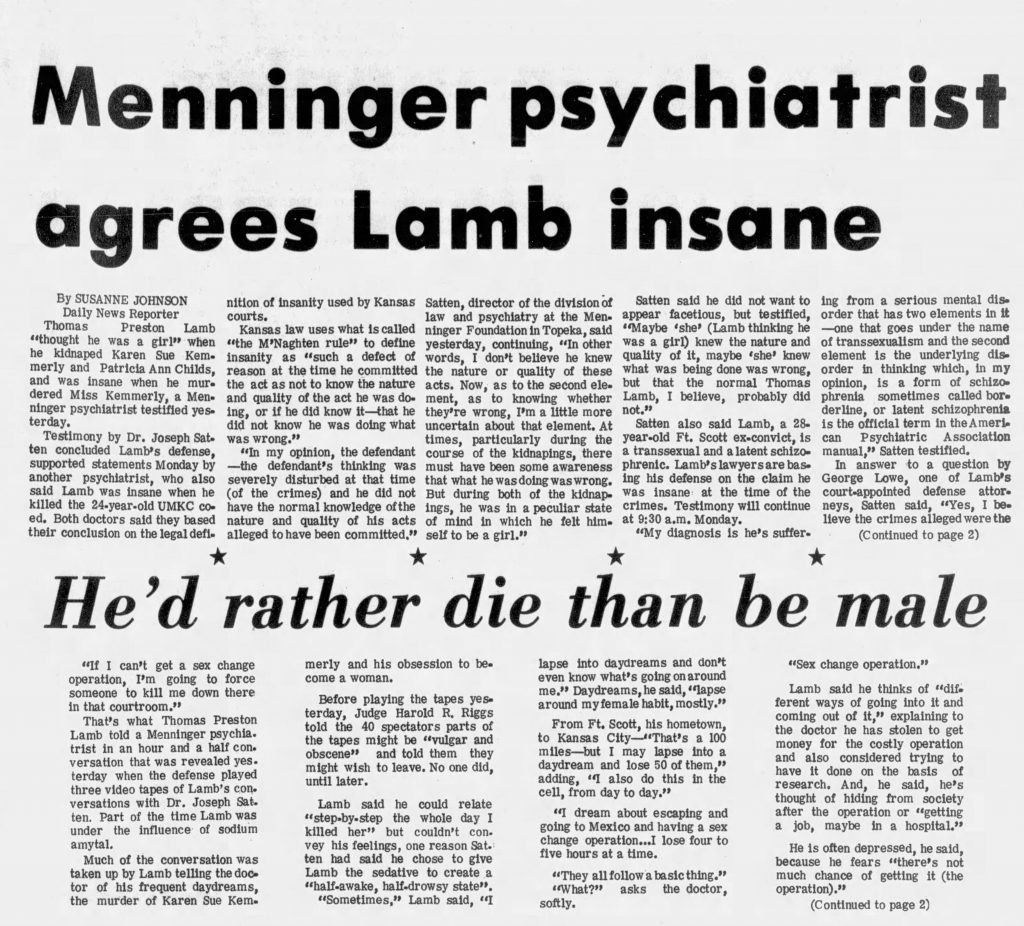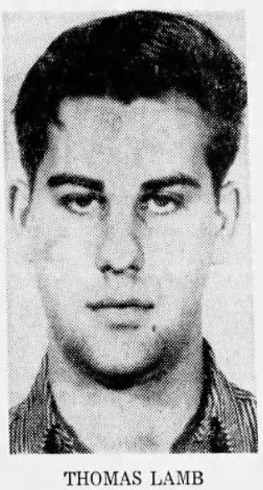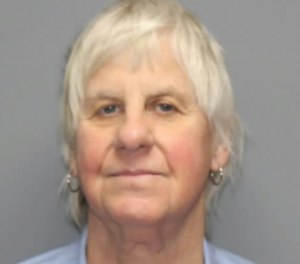A Kansas man convicted for the brutal murder of one woman and the kidnapping of another has begun identifying as transgender while incarcerated and was quietly transferred to a women’s prison in Topeka just days ago. Thomas Preston Lamb, 81, now uses the name Michelle Renee Lamb and is described as “female” in the state Criminal Justice Information System. Lamb was transferred to Topeka Correctional Facility, the state’s only prison for women, on January 27.
Lamb was convicted of kidnapping and murdering Karen Sue Kemmerly, a 24 year-old student at the University of Kansas-Missouri, around December 5, 1969.
Lamb murdered Kemmerly after she commented he was a “handsome man,” which sent him into a violent rage as he saw himself as a woman. Lamb strangled the woman to death, and left her nude corpse in a cornfield. The young student’s body was found approximately five days after her death on December 7.
In addition to Kemmerly, Lamb was also convicted on charges of kidnapping 18-year-old Patricia Ann Childs on January 15, 1970. Childs was returned to her family after her father paid out a $3,500 ransom demanded by Lamb. During the ordeal, Lamb bound Childs’ hands and raped her, according to court documents, though he was never formally charged for the sexual assault.
Lamb was ultimately convicted of two counts of kidnapping and one count of first degree murder, and is now serving three consecutive life sentences in prison. While in prison, Lamb began going by Michelle Renee Lamb, and in 2007, filed for a legal name change, court records reveal.

While detained and awaiting trial for the abductions and murder, Lamb escaped from the Johnson County jail with another inmate, but was apprehended in LaCygne four hours later. During the incident, Lamb and his accomplice held a 50-year-old Olathe man hostage.
On February 25, 1970, Lamb was ordered to undergo a psychiatric evaluation. Lamb, who waived his right to a jury trial, was interviewed by Dr. Joseph Satten, a psychiatrist specializing in criminology at the Menninger Foundation in Topeka, who filmed the exchange. The video was shown in court as evidence to support an insanity plea. Before playing the recording for the spectators, Judge Harold Riggs warned of “vulgar and obscene” content.
“In my opinion, the defendant’s thinking was severely disturbed at the time of the crimes and he did not have the normal knowledge of the nature and quality of his acts alleged to have been committed,” Satten testified. “Now, as to the second element, as to knowing whether they’re wrong, I’m a little more uncertain.”
Lamb told Satten that he “thought he was a girl” when he carried out the crimes against the two women. It was Satten’s view that Lamb was “intelligent” and aware of the crimes he committed. However, he emphasized “peculiarities” in his personality.

“At times, during the course of the kidnappings, there must have been some awareness that what he was doing was wrong. But during both of the kidnappings, he was in a peculiar state of mind in which he felt himself to be a girl,” Satten said.
The doctor went on to blame the “female version” of Lamb for the crimes, insinuating that the “male version” of Lamb was not mentally present during the time of the offenses.
“Maybe ‘she’ knew the nature and quality of it, maybe ‘she’ knew what was being done was wrong, but the normal Thomas Lamb, I believe, probably did not,” Satten added.
The doctor continued that Lamb had an “overriding preoccupation that all of his problems revolved around the need to have a sex reassignment operation.” In a seemingly contradictory statement, Satten said that Lamb did not hold prejudices against women, but believed “they have all the advantages.”
Satten pointed out that Lamb had a “capacity to slide into fantasy thinking” and could be “unable to tell the difference between reality and fantasy.” The killer, Satten said, told his mother that he “liked to feel and touch” women’s undergarments.
“If I can’t get a sex change operation, I’m going to force someone to kill me down there in that courtroom,” Lamb told Satten. Describing his fantasies, Lamb said: “I lapse into daydreams and don’t even know what’s going on around me,” and clarified that his daydreams centered around his “female habit.”
Using the example of commuting the 100-miles from Ft. Scott to Kansas City, Lamb told the doctor, “That’s 100 miles… but I may lapse into a daydream and lose about 50 of them. I also do this in the cell, day to day.”
The killer’s mother, Hazel Irene Lamb, told prosecutors she had found women’s undergarments in her son’s dresser beginning from the time he was about ten years old. “I found my panties I had discarded in the rag bag in his dresser drawer,” she said, and noted that similar instances had occurred often.
Prior to his criminal behavior, Lamb had been honorably discharged from the U.S. Navy because he was deemed “not suitable” and there was “evidence of significant psycho-sexual confusion.” Lamb, Satten said, went through a brief period in the “gay world in Kansas City”, but the experience “disgusted and frightened” him.
“My diagnosis is he’s suffering from a serious mental disorder that has two elements in it — one that goes under the name of transsexualism and the second element in the underlying disorder in thinking, which, in my opinion, is a form of schizophrenia sometimes called borderline, or latent schizophrenia,” Satten testified.
Lamb’s attorney, George Lowe, recounted the motivation for murdering Kemmerly as stated by Mark Bennett, assistant county attorney: “there was some sexual activity in the course of which some statements that she made to him angered him and seemed to him like a mockery. There was a quarrel between the two of them, and in the course of the quarrel he strangled her.”

A psychiatrist who evaluated Lamb in 1965 after his first conviction for theft stated that his obsession with women’s clothing was “central to his legal difficulties.” Dr. Hector Cavallin testified that Lamb, then 25 years old, had committed the burglary with the intent of using the stolen money to buy more clothing. Lamb, Cavallin said, “had a severe emotional disturbance,” and his tranvestic fetish was “one manifestation of his illness.”
While serving a sentence of one to five years at the Kansas state prison for burglary and larceny, Lamb escaped, taking a guard hostage. He was soon discovered hiding in an unoccupied house three blocks away, wearing women’s clothing and in possession of a butcher knife. Lamb was later released on parole in 1969, when he committed the murder and abductions.
Cavallin came to two final conclusions about Lamb’s psychiatric condition, and said that his “sexual deviation and borderline personality” indicated that he functioned “someplace between the psychotic and the neurotic.” Yet the doctor also expressed that he had no conclusive opinion as to Lamb’s sanity or insanity at the time he committed the kidnappings and murder.
When describing details leading up to the killing, Lamb told Cavallin that he strangled Kemmerly after “the girl told him he was a handsome man.”
“But he didn’t want to be handsome, he wanted to be pretty,” the psychiatrist said, adding that Kemmerly had an intimate relationship with Lamb and told him he was “very capable sexually.” Both comments, the doctor testified, infuriated Lamb “because he wanted to be a woman.”
Cavallin further explained that Lamb showed “no evidence of homosexual practices or wish for homosexuality.” Lamb told the psychiatrist that he found same-sex attracted individuals “repugnant.”

During cross-examination, Cavallin considered the insanity plea, stating, “It is possible when he killed this girl, he knew right from wrong, but he didn’t later on. I don’t believe Mr. Lamb knew who he was, he thought he was a girl.”
An additional prosecution psychiatrist Dr. Herbert Spiegel, told the court that Lamb showed a “minimal amount of emotion” while recalling details of the abductions and murder. According to Spiegel, Lamb was aware of his criminal behavior.
Additionally, associate professor of psychiatry at the University of Kansas Medical Center, Dr. William McKnelly, described Lamb’s “core difficulty” as “an anti-social personality and a gender difficulty known as transsexualism.”
Lamb was given “female undergarments” by the Kansas Department of Corrections (KDOC) while incarcerated, with the intimate clothing described as “therapeutic for Lamb’s gender dysphoria.” He has also been provided with estrogen and testosterone-blocking drugs.
In a 2017 motion filed by Lamb against the KDOC, he alleged that his Eighth Amendment rights against cruel and unusual punishment were being violated. The convicted killer demanded “more comprehensive treatment of her gender dysphoria, access to more female items in prison, recognition of her name change, and transfer to a female-only prison facility.”
Further accommodations requested by Lamb included “castration surgery; genital sex reassignment surgery; female voice therapy, electrolysis, and/or laser hair removal.” To support his position, Lamb cited guidelines published by the World Professional Association for Transgender Health (WPATH).
Lamb’s 2017 request to be transferred to a women’s correctional facility was denied by District Judge Eric Melgren. In the decision, it was stated that “Lamb is not entitled to transfer to a female facility.”
“Although Lamb argues that ‘transfer does not raise serious safety and security concerns,’ the Court cannot overlook the heinous crimes for which Lamb is serving three life sentences. Thomas Lamb murdered Karen Sue Kemmerly — a woman. Shortly thereafter, he kidnapped Patricia Ann Child — another woman — and forced her to have sex with him while she was held against her will,” Judge Melgren asserted.

He continued, referring to Lamb with feminine pronouns: “Thomas was ordered to serve three life sentences so that he would never kill or hurt another woman again. Thomas is now Michelle, but Michelle is still a convicted kidnapper and murderer of women, and the justification for her sentence has not changed.”
Last year, public outcry ensued after it came to light that a convicted pedophile was lobbying for gender self-identification prison reforms in the state of Kansas. Rayne Bennett, formerly known as Jacob Lawrence Pina, was convicted in 2016 of indecent liberties with a child and was placed on a sex offender registry for 25 years. According to the 2016 KSN News coverage on the attack, Bennett forcibly imprisoned the girl at his residence and raped her.
Despite this, Bennett was utilized as a source to decry the hardships faced by trans inmates in Kansas in a number of news articles. In January 2022, Bennett was profiled in the Kansas City branch of NPR. Days later, he was sourced for a similar article in The Topeka Capitol-Journal. The following week, the Leavenworth Times also sympathetically profiled Bennett.
Bennett was given multiple platforms to complain about poor treatment by Kansas correctional staff, and to advocate for convicted men to be legally permitted to transfer into women’s institutions based on self-identification.
Reduxx is your source of pro-woman, pro-child safeguarding news and commentary. We’re 100% independent! Support our mission by joining our Patreon, or consider making a one-time donation.
